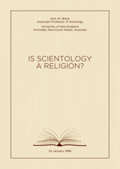As a sociologist with a specialization in the study of religion, I have been asked to address the question “Is Scientology a religion?” In answering that question, I am not pronouncing on the truth or falsity of Scientology. Rather, I am considering whether Scientology meets the criteria commonly used to define a religion. These criteria are not entirely clear-cut: various writers have offered different definitions. These range all the way from that of W.G. Runciman,1 who uses the term as synonymous with “ideology,” to that of Werner Cohn,2 who argues that the English word “religion” is so complex and so culture-specific that it is inappropriate to use it with reference to any aspect of non-Western or non-Christianized cultures.
Most scholars in this field would nevertheless agree that a religion is a system of beliefs and practices with a supernatural, sacred or transcendent point of reference. Consistent with this starting point, it is possible to identify various characteristics found in most, if not all, recognized religions. The more fully a particular system of beliefs and practices displays these characteristics, the more unequivocally one can regard it as a religion.
In identifying the characteristics typically found in religions, I shall make use of the framework put forward by Ninian Smart, one of the leading scholars of the world’s religions.3 As I have used the broad features of this framework in some of my previous writings,4 it is not being adopted merely for the purposes of the present study.
I am not a Scientologist. In formulating my conclusions, I have made a detailed study of Scientology publications, as well as observing activities at the Church of Scientology in Sydney and interviewing some of the participants. I am also familiar with various sociological studies of Scientology in other parts of the world.
The main Scientology publications I have studied are the following, arranged in order of their dates of first publication:
Dianetics: The Modern Science of Mental Health (1950)
Dianetics: The Evolution of a Science (1950)
Science of Survival (1951)
Advanced Procedure and Axioms (1951)
Scientology: A History of Man (1952)
Scientology 8-80 (1952)
Scientology 8-8008 (1952)
The Phoenix Lectures (presented 1954, published 1968)
The Creation of Human Ability (1955)
Scientology: The Fundamentals of Thought (1956)
Have You Lived Before This Life? (1960, revised and expanded 1977)
Introduction to Scientology Ethics (1968, revised and updated 1989)
Scientology 0-8: The Book of Basics (1970)
The Background and Ceremonies of the Church of Scientology (1970)
Mission into Time (1973, an expanded version of A Test of Whole Track Recall, 1968)
The Way to Happiness (1981)
Understanding the E-Meter (1982, revised 1988)
What Is Scientology? (1992)
The Scientology Handbook, based on the works of L. Ron Hubbard (1994)
The Church of Scientology, 40th Anniversary (1994)
All of the above publications have official standing within the Church of Scientology, nearly all being writings of L. Ron Hubbard. Those which are not wholly authored by Hubbard draw heavily on his work. Quotations or references given below are to the latest available edition in English.
1. W.G. Runciman, “The Sociological Explanation of ‘Religious’ Beliefs,” Archives Européennes de Sociologie 10 (1969):149–191.
2. Werner Cohn, “Is Religion Universal? Problems of Definition,” Journal for the Scientific Study of Religion 2 (1962):25–33.
3. Smart was Professor of Religious Studies at the University of Lancaster (in Britain) from 1967 to 1982. He has been a Professor in the Department of Religious Studies at the University of California at Santa Barbara since 1976, and is currently the J.F. Rowney Professor of Comparative Religions there.
4. For example, Alan W. Black and Peter E. Glasner, eds. Practice and Belief: Studies in the Sociology of Australian Religion, Sydney: Allen and Unwin, 1983.





























